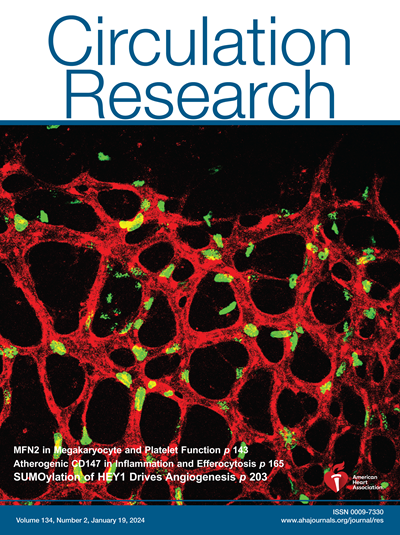CEMIP Maintains Vascular Contractility by Controlling PP1c-MLC20 Cascade in SMCs.
IF 16.2
1区 医学
Q1 CARDIAC & CARDIOVASCULAR SYSTEMS
引用次数: 0
Abstract
BACKGROUND The CEMIP (cell migration-inducing protein) exhibits extremely high expression levels in smooth muscle tissues. However, whether CEMIP modulates the contractile phenotype of vascular smooth muscle cells and confers blood pressure remains elusive. METHODS To explore the role of CEMIP in SMCs, we generated a mouse model with SMC-specific CEMIP deficiency (SMC-CemipKO). By combining coimmunoprecipitation assay and molecular docking prediction, we identified MLC20 (myosin light chain 20) and its phosphatase, PP1c (protein phosphatase 1c) as binding proteins for CEMIP. To elucidate the mechanism by which CEMIP interacts with MLC20 and PP1c, bioluminescence resonance energy transfer assay and motif mutation were utilized to unravel the intricate network. RESULTS CEMIP is abundantly expressed in smooth muscle tissues including the mesenteric artery, aorta, and intestine. In a serum-starved contractile phenotype, SMCs responded to serum stimulation by gradually decreasing CEMIP expression, as they shifted to a secretory phenotype. The mice lacking CEMIP in SMCs showed significantly reduced contractility and blood pressure compared with their counterparts of age-matched wild-type littermates (Cemipflox/flox). Mechanistically, we demonstrated that CEMIP directly interacted with MLC20 to maintain its phosphorylation. In addition, CEMIP sequestered MLC20 from its phosphatase, PP1c, without affecting the kinase MLCK (myosin light chain kinase). Moreover, CEMIP contains 3 critical RVxF motifs that are responsible for binding to PP1c. Mutations in these motifs restored the interaction between PP1c and MLC20. CONCLUSIONS CEMIP functions as a gatekeeper for maintaining the contractile phenotype of SMCs via the PP1c-MLC20 cascade. CEMIP is indispensable for maintaining blood pressure.CEMIP通过控制SMCs中PP1c-MLC20级联维持血管收缩。
背景CEMIP(细胞迁移诱导蛋白)在平滑肌组织中表现出极高的表达水平。然而,CEMIP是否调节血管平滑肌细胞的收缩表型并赋予血压仍然难以捉摸。方法为了探索CEMIP在SMCs中的作用,我们建立了SMCs特异性CEMIP缺陷(SMC-CemipKO)小鼠模型。结合共免疫沉淀法和分子对接预测,我们确定了肌球蛋白轻链20 (MLC20)及其磷酸酶PP1c(蛋白磷酸酶1c)是CEMIP的结合蛋白。为了阐明CEMIP与MLC20和PP1c相互作用的机制,利用生物发光共振能量转移实验和基序突变来解开这个复杂的网络。结果scemip在包括肠系膜动脉、主动脉和肠在内的平滑肌组织中大量表达。在血清缺乏的收缩表型中,SMCs通过逐渐降低CEMIP表达来响应血清刺激,因为它们转变为分泌型表型。SMCs中缺乏CEMIP的小鼠与同龄野生型幼崽(Cemipflox/flox)相比,收缩力和血压明显降低。在机制上,我们证明了CEMIP直接与MLC20相互作用以维持其磷酸化。此外,CEMIP将MLC20从其磷酸酶PP1c中分离出来,而不影响MLCK(肌球蛋白轻链激酶)。此外,CEMIP含有3个关键的RVxF基序,负责与PP1c结合。这些基序的突变恢复了PP1c和MLC20之间的相互作用。结论scemip通过PP1c-MLC20级联维持SMCs的收缩表型,起到守门人的作用。CEMIP对于维持血压是不可或缺的。
本文章由计算机程序翻译,如有差异,请以英文原文为准。
求助全文
约1分钟内获得全文
求助全文
来源期刊

Circulation research
医学-外周血管病
CiteScore
29.60
自引率
2.00%
发文量
535
审稿时长
3-6 weeks
期刊介绍:
Circulation Research is a peer-reviewed journal that serves as a forum for the highest quality research in basic cardiovascular biology. The journal publishes studies that utilize state-of-the-art approaches to investigate mechanisms of human disease, as well as translational and clinical research that provide fundamental insights into the basis of disease and the mechanism of therapies.
Circulation Research has a broad audience that includes clinical and academic cardiologists, basic cardiovascular scientists, physiologists, cellular and molecular biologists, and cardiovascular pharmacologists. The journal aims to advance the understanding of cardiovascular biology and disease by disseminating cutting-edge research to these diverse communities.
In terms of indexing, Circulation Research is included in several prominent scientific databases, including BIOSIS, CAB Abstracts, Chemical Abstracts, Current Contents, EMBASE, and MEDLINE. This ensures that the journal's articles are easily discoverable and accessible to researchers in the field.
Overall, Circulation Research is a reputable publication that attracts high-quality research and provides a platform for the dissemination of important findings in basic cardiovascular biology and its translational and clinical applications.
 求助内容:
求助内容: 应助结果提醒方式:
应助结果提醒方式:


